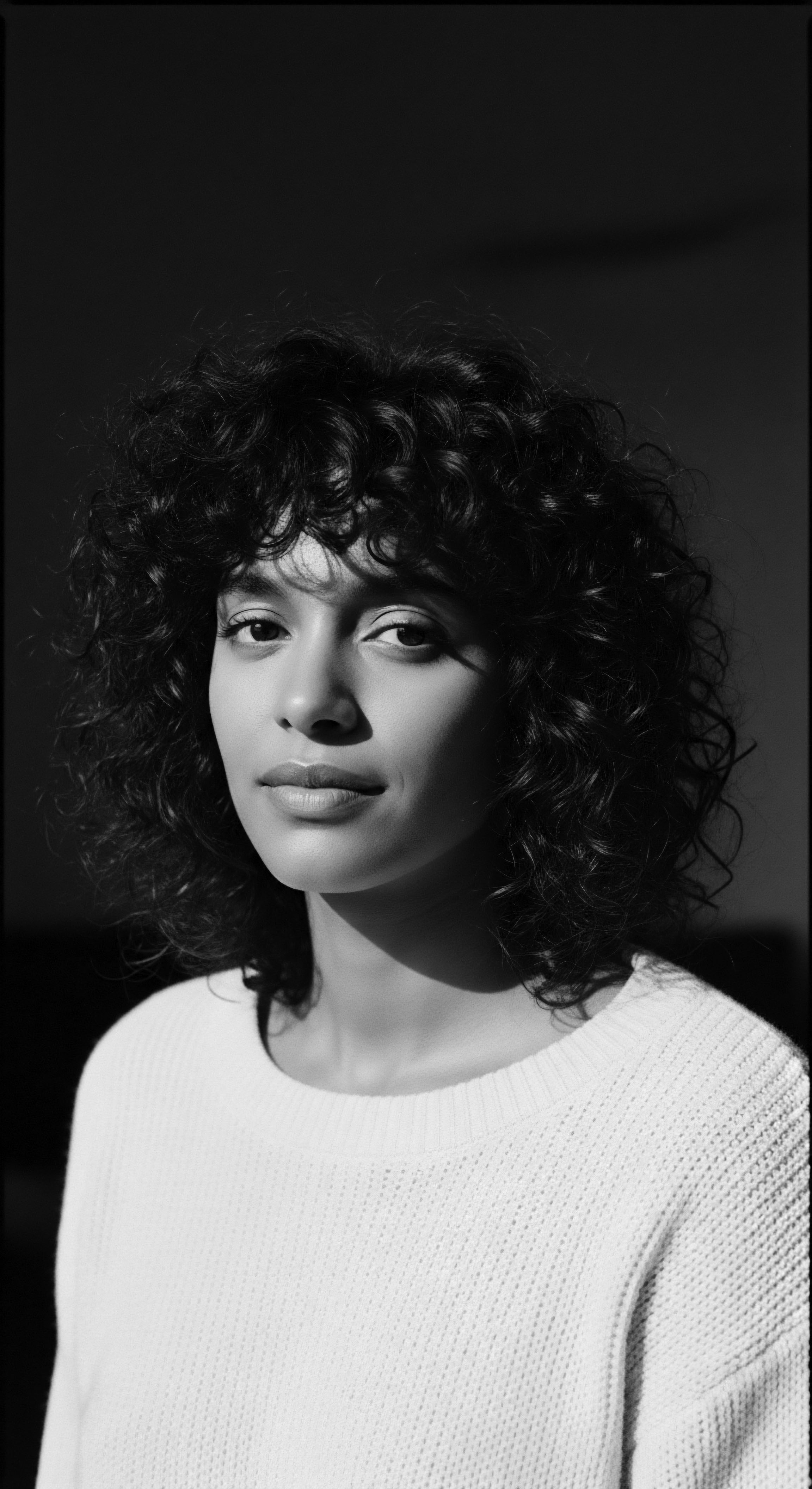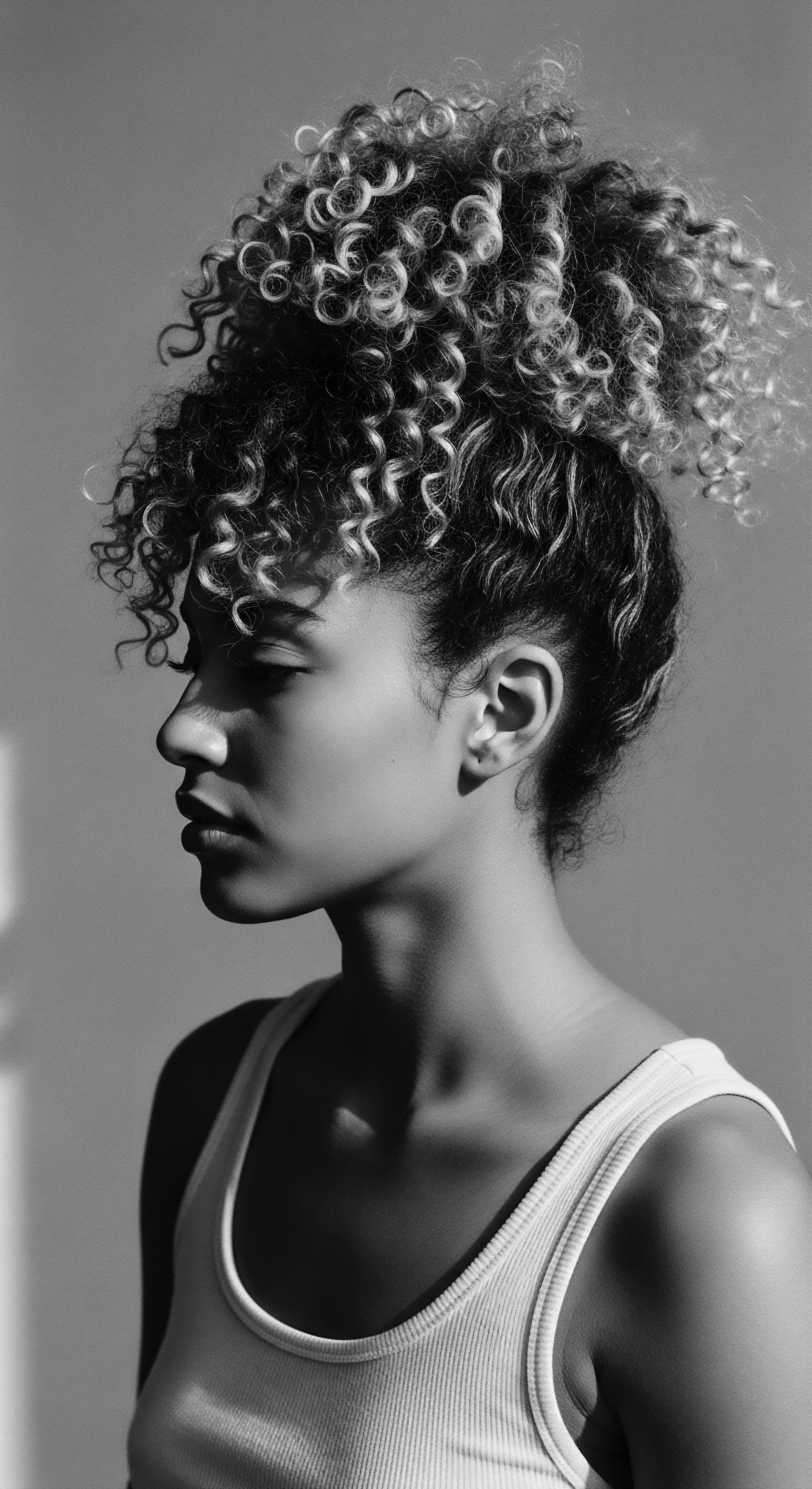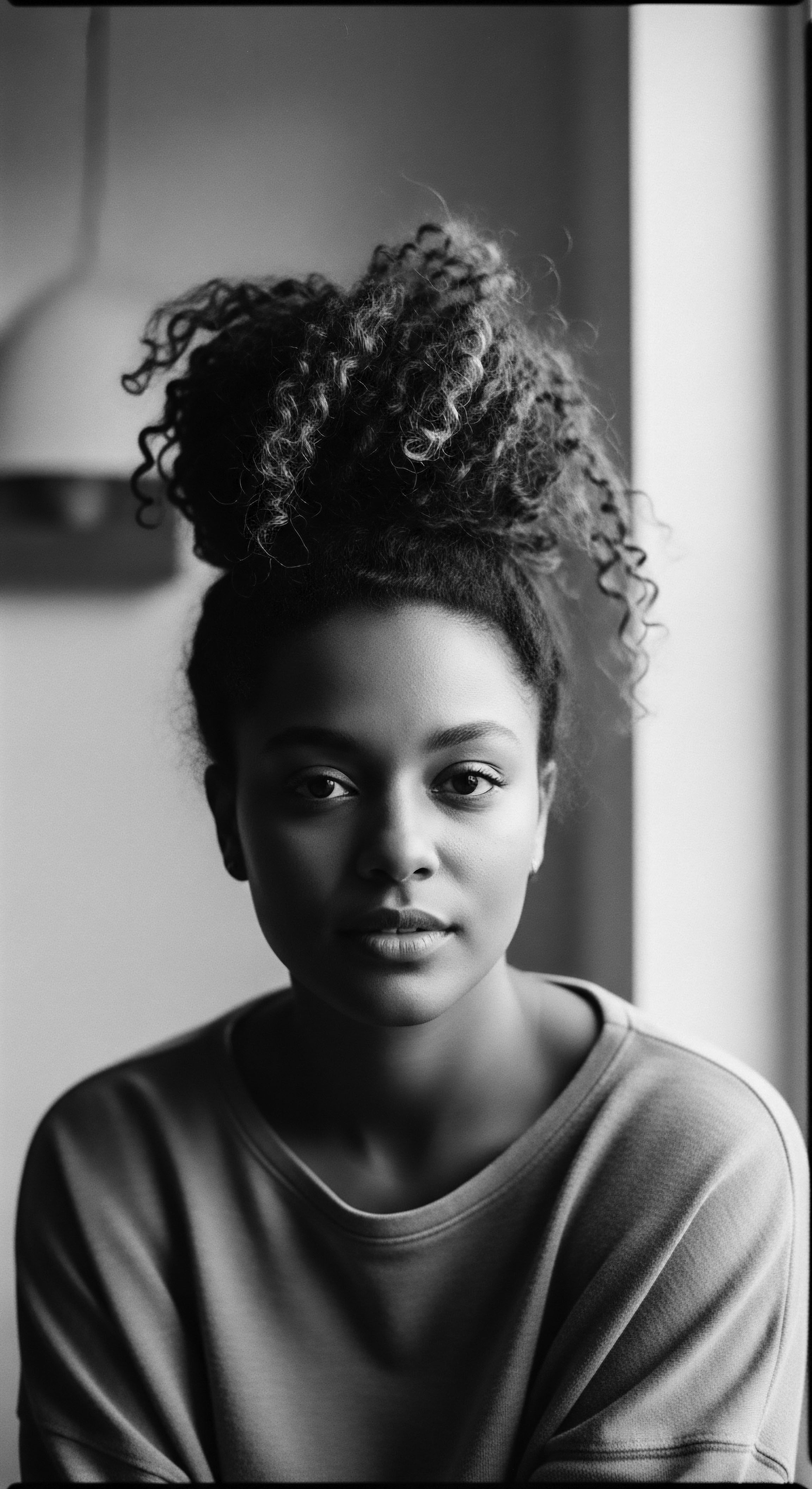
Roots
The journey into textured hair coverings begins not in recent memory, but in the echoes of distant drums and the sun-drenched landscapes where humanity first braided wisdom into being. For those whose hair coils and kinks with the undeniable memory of ancient suns, the covering of one’s crown is far more than a stylistic choice. It is a dialogue with ancestry, a quiet conversation across generations, an affirmation that reverberates with the soul of a strand. Each wrapped fabric, each precisely placed bonnet, speaks a language understood intuitively, a lexicon of protection, identity, and profound belonging that reaches back to civilizations where hair was a map, a chronicle, a living shrine.
Consider the earliest expressions of this profound connection. In various West African societies, the adornment and covering of hair held deep spiritual and social significance. Headwraps, often crafted from richly dyed and patterned textiles like Kuba cloth from the Democratic Republic of Congo or intricate woven raffia, were not merely decorative. They served as powerful communicators of one’s marital status, age, social standing, or even spiritual devotion.
A young woman might wear a vibrant wrap signaling her eligibility for marriage, while an elder’s dignified, carefully folded headpiece spoke volumes of her wisdom and authority within the community. This practice of covering, therefore, extended beyond practical considerations of hygiene or warmth; it became an outward manifestation of an inner world, a visual testament to the interwoven threads of personal journey and collective history.
What elemental forces guided the earliest ancestral wisdom regarding textured hair and its coverings?
The very biology of textured hair, with its unique helical structure and propensity for dryness due to the uneven distribution of natural oils, naturally inclined ancestral communities towards practices that shielded it from environmental stressors. The harsh rays of the sun, the drying winds of arid climates, and the abrasive dust of daily life posed challenges to the delicate cuticle layer. Early coverings, made from natural fibers, acted as a fundamental barrier, mitigating moisture loss and reducing physical damage from external elements. This was an intuitive science, perhaps not articulated with modern terminology, but deeply understood through observation and lived experience.
The ancestral wisdom observed how unprotected hair could become brittle, prone to breakage, and lose its vitality. They responded with ingenious solutions, using what the earth provided to safeguard what was considered sacred.
Ancestral wisdom concerning textured hair coverings stemmed from an intuitive understanding of environmental protection and cultural identity, long before modern scientific validation.
For instance, the use of plant fibers like cotton or woven grasses, or even carefully treated animal hides, would have provided insulation against temperature fluctuations and minimized tangling during arduous daily tasks. These initial coverings established a precedent, a foundational understanding that the hair, particularly its vulnerable tips and the sensitive scalp, required a sanctuary. This protection allowed for longer hair growth, better retention of length, and thus, more elaborate styles which, in turn, could signify even greater social or spiritual standing. The practice became cyclical ❉ protective covering led to healthier hair, which enabled more complex cultural expressions, reinforcing the value of the covering itself.
| Ancestral Purpose Protection from elements (sun, wind, dust) |
| Modern Reflection Mitigation of environmental damage and moisture loss |
| Ancestral Purpose Indication of social status and identity |
| Modern Reflection Statement of cultural pride and personal style |
| Ancestral Purpose Spiritual connection and reverence |
| Modern Reflection Personal wellness and mindful hair care rituals |
| Ancestral Purpose Preservation of intricate hairstyles |
| Modern Reflection Maintenance of styling longevity and definition |
| Ancestral Purpose The enduring wisdom of covering textured hair spans millennia, adapting to new forms while preserving its core protective and expressive functions. |
The enduring lexicon of textured hair itself carries whispers of this ancient knowing. Terms like “kinky,” “coily,” and “nappy,” though sometimes burdened by colonial interpretations, originally described the beautiful, resilient variations found in hair strands. Ancestral communities likely had their own rich, descriptive vocabularies for these textures, words that honored their unique characteristics rather than pathologizing them. The coverings became a means to preserve these diverse expressions, ensuring the health of the strands that formed the basis of elaborate cultural artistry.
This initial codex, passed down through oral traditions and embodied practices, forms the “Roots” from which all modern understandings of textured hair coverings draw sustenance. It reminds us that the instinct to shield, adorn, and honor our hair is as old as time, a heritage etched into our very being.

Ritual
From the foundational understandings of ancient protection, the practice of covering textured hair matured into something more structured, more rhythmic ❉ a ritual. This transition speaks to a deeper integration of hair care into daily life, becoming less about rudimentary survival and more about intentional preservation, cultural continuity, and holistic wellbeing. Modern textured hair coverings, such as bonnets, durags, and silk scarves, are not mere accessories; they are direct descendants of these ancient rites, vessels carrying forward the wisdom of moisture retention, friction reduction, and style preservation across oceans and centuries. The whispers of old practices resonate in the rustle of a satin bonnet donned before sleep, a testament to a heritage that recognizes hair as a living, sacred entity deserving of reverence.
How do modern nighttime hair coverings echo ancestral care practices?
Consider the sacredness of rest. Ancestral communities intuitively understood the importance of protecting hair not only during waking hours but also during periods of repose. While specific archaeological evidence for “bonnets” as we know them might be limited for deep antiquity, the principle of creating a protective enclosure for hair during sleep would have been a natural extension of daytime covering practices. Sleeping on abrasive surfaces, like rough woven mats or uncovered ground, would have led to significant friction and moisture loss for delicate textured strands.
The transition to softer materials, perhaps finely spun cottons or other plant fibers, to cushion the hair and preserve intricate styles, represents an evolutionary step in this ritualistic care. This foresight is precisely what modern satin or silk-lined bonnets accomplish. These smooth fabrics drastically reduce friction, preventing breakage and frizz, and unlike absorbent cotton pillowcases, they do not wick away the hair’s precious natural oils and applied moisture. This scientific validation of an age-old intuition underscores the profound efficacy of ancestral observations.
The deep connection between modern hair coverings and ancestral wisdom is beautifully exemplified by the Tignon Laws of Louisiana, enacted in 1786. These laws mandated that free women of color in New Orleans wear a tignon, a specific type of head covering, when in public. The intention behind these laws was to visually distinguish and subordinate free women of color, whose elaborate hairstyles and vibrant adornments often challenged the social hierarchy and attracted admiration. Yet, these women, with ancestral ingenuity, transformed an oppressive decree into a powerful act of resistance and cultural expression.
They adorned their tignons with vibrant colors, luxurious fabrics, and artful arrangements, turning a symbol of subjugation into a statement of unparalleled style, dignity, and defiance. This historical instance demonstrates how coverings, even when imposed, became a canvas for ancestral wisdom regarding self-expression and resilience, a visual assertion of identity in the face of adversity (Baum, 1999). The modern headwrap, worn with pride, connects directly to this lineage of resilience and sartorial resistance.
The donning of hair coverings, especially at night, represents a continuum of ancestral care, protecting fragile strands from environmental damage and preserving intricate styles with thoughtful intention.
The materials themselves carry a heritage. While silk and satin might seem like modern innovations for hair care, the ancestral use of materials with similar properties – perhaps finely processed bark cloth, smooth animal hides, or tightly woven plant fibers – points to an understanding of what minimized damage. The traditional practice of oiling and braiding hair before covering it, a common ritual in many African cultures, further protected strands, locking in moisture and preparing them for the repose of the night. This layering of protective measures – internal nourishment through oils and external shielding via coverings – reflects a holistic approach to hair health that modern regimens strive to emulate.
- Oiling ❉ Many ancestral traditions used plant-derived oils, like shea butter or coconut oil, to lubricate strands before covering, mimicking the natural oils the hair needs.
- Braiding/Twisting ❉ Hair was often styled into braids or twists before covering, reducing tangling and knotting that could occur during sleep or daily activities.
- Gentle Fabrics ❉ Though not always silk, softer, less abrasive natural fibers were likely chosen for coverings to minimize friction on delicate hair.
- Ritualistic Application ❉ The act of preparing hair for rest and then covering it was often a quiet, mindful ritual, fostering a connection to one’s body.
| Ancestral Material/Concept Woven plant fibers (e.g. raffia, cotton) |
| Key Property Breathability, natural texture |
| Modern Hair Covering Equivalent Cotton headwraps, breathable turbans |
| Ancestral Material/Concept Smooth animal skins (inner lining) |
| Key Property Low friction, natural oils |
| Modern Hair Covering Equivalent Satin-lined bonnets and durags |
| Ancestral Material/Concept Complex wrapping techniques |
| Key Property Secure hold, style preservation |
| Modern Hair Covering Equivalent Structured headwraps, pre-tied scarves |
| Ancestral Material/Concept The enduring principles of protection and preservation guide both ancestral material choices and modern fabric innovations for textured hair. |
These rituals, once performed around crackling fires under vast night skies, now occur in the quietude of modern homes. Yet, the intent remains unchanged ❉ to honor the hair, to protect its integrity, and to continue a lineage of care that recognizes the profound connection between our strands and our spirit. The covering becomes a tender embrace, a conscious act of wellness that acknowledges the hair’s heritage and its needs.

Relay
The journey of ancestral wisdom in textured hair coverings continues its relay through time, a vibrant, unbroken chain of knowledge and adaptation. This transmission of understanding is not a static preservation of the past but a dynamic reinterpretation, where ancient principles are expressed through contemporary forms and scientific insights often validate long-held cultural practices. The very act of wearing a modern bonnet or durag, seemingly simple, becomes a complex interplay of historical lineage, material science, and the ever-present dialogue between personal identity and collective memory. The legacy of protection and adornment, steeped in the unique journey of textured hair, finds its continuity in these daily gestures.
How do contemporary textured hair coverings serve as a bridge between ancient protective practices and modern scientific understanding?
At its core, the science of textured hair reveals a unique architecture. The elliptical shape of the follicle, which produces an oval or flat hair shaft, causes the hair to curl and coil, creating natural points of vulnerability where the strand bends and twists. This structural reality, combined with fewer cuticle layers in certain areas of the curl, makes textured hair more susceptible to mechanical stress, breakage, and moisture evaporation compared to straight hair. Ancestral communities, without microscopes or chemical analyses, intuitively recognized this fragility.
Their solutions – oiling, braiding, and then covering the hair – directly addressed these challenges. Modern scientific research confirms the efficacy of these methods. A study published in the International Journal of Cosmetic Science, for instance, details how friction from materials like cotton can indeed cause significant cuticle damage and protein loss in hair fibers (Robbins, 2012). This corroborates the ancestral rationale for using smoother materials or protective styles before covering, effectively reducing the daily assault on the hair shaft.
The modern use of satin and silk in bonnets and pillowcases is a direct scientific evolution of this ancestral wisdom. These fabrics possess a smooth, tightly woven surface that minimizes the coefficient of friction between the hair and the material, thereby reducing tangling, snagging, and cuticle abrasion. Furthermore, unlike cotton, which is highly absorbent, silk and satin do not draw moisture away from the hair. This property is paramount for textured hair, which naturally tends towards dryness.
The ancestral practice of wrapping hair in finely woven or naturally smooth materials was, in essence, an early form of friction reduction and moisture retention, albeit without the scientific nomenclature. The relay, then, is the application of contemporary material science to optimize these age-old, tried-and-true principles.
Modern hair coverings, especially those made from satin or silk, validate ancestral wisdom by scientifically optimizing friction reduction and moisture retention for textured hair.
Beyond the purely scientific, the relay encompasses the profound cultural and social dimensions. Head coverings, through the diaspora, became powerful visual cues for identity and resilience. From the elaborate headties of Caribbean women, signaling both heritage and status, to the urban durag, protecting waves and representing a distinct cultural aesthetic, the ancestral memory of covering for identity and protection persists.
These modern expressions often carry complex layers of meaning, sometimes as acts of self-affirmation, other times as symbols of solidarity within communities. The choice to wear a head covering can be a quiet act of cultural pride, a nod to traditions that survived enslavement and colonial oppression.
Consider the global propagation of these practices. As diasporic communities spread, so too did the knowledge of textured hair care and covering. What started as localized, indigenous practices became interwoven with new cultural contexts.
The intricate wrapping styles seen in Brazil’s Bahia or among Creole communities in Louisiana, for instance, blend African aesthetics with new world influences, yet the underlying ancestral principles of protection and adornment remain. The choice of fabrics, the methods of tying, and the occasions for wear may shift, but the core wisdom endures.
- Diasporic Adaptation ❉ Ancestral covering practices adapted to new environments and materials in the Americas and beyond, often blending with indigenous or colonial aesthetics while retaining core protective functions.
- Symbol of Resilience ❉ Head coverings served as symbols of cultural identity and resistance, particularly in contexts where African traditions were suppressed.
- Fashion Evolution ❉ Contemporary fashion has reinterpreted traditional headwraps, bringing them into mainstream consciousness while sometimes disconnecting them from their deep heritage.
- Scientific Validation ❉ Modern textile science and hair biology research often affirm the intuitive effectiveness of ancestral hair protection methods, including covering.
The relay of ancestral wisdom is therefore a testament to continuous innovation within a framework of deeply rooted knowledge. It speaks to the ingenuity of communities who, through observation and inherited practice, developed sophisticated strategies for hair health that science now meticulously dissects and confirms. It is a powerful reminder that some of the most advanced solutions for textured hair care today have their origins in the timeless wisdom of our ancestors.

Reflection
As the final threads of this exploration settle, a profound truth emerges ❉ modern textured hair coverings are not isolated innovations but living extensions of an enduring ancestral wisdom. Each bonnet, each scarf, each carefully tied wrap carries within its folds the memory of countless generations who understood, long before microscopes and chemical analyses, the intrinsic value and unique needs of coily and kinky strands. This heritage, deeply woven into the very fabric of Black and mixed-race experiences, reminds us that the instinct to protect, adorn, and honor our hair is as ancient as it is vital.
The “Soul of a Strand” ethos, in this light, reveals itself as a deep reverence for this inherited knowledge. It acknowledges that the helical structure of our hair, its propensity for dryness, and its inherent strength in numbers were all understood by ancestors who crafted solutions from what the earth provided. The gentle draping of cloth for nighttime preservation, the intricate wrapping for daytime distinction, the use of natural materials to shield against the elements – these were not mere acts of fashion. They were acts of devotion, of resilience, of cultural affirmation.
Today, as we reach for a satin bonnet or master a headwrap technique, we are not simply engaging in a beauty regimen. We are participating in a continuum, a living library of practices passed down through whispers, observation, and necessity. We are honoring the ingenuity of those who came before us, validating their intuitive science, and reinforcing the idea that true wellness for textured hair is inextricably linked to its rich and vibrant heritage. This reflective understanding allows us to appreciate not just what these coverings do for our hair, but what they say about us – our connection to a lineage of wisdom, our enduring spirit, and the timeless beauty of our unique strands.

References
- Baum, D. (1999). ‘The Tignon and the Negotiation of Status in Colonial New Orleans’. In R. F. Foster (Ed.), New Orleans Culture and History. University Press of Mississippi.
- Robbins, C. R. (2012). Chemical and Physical Behavior of Human Hair (5th ed.). Springer Science & Business Media.
- Byrd, A. D. & Tharps, L. L. (2001). Hair Story ❉ Untangling the Roots of Black Hair in America. St. Martin’s Press.
- Mercer, K. (1994). Welcome to the Jungle ❉ New Positions in Black Cultural Studies. Routledge.
- Sweet, R. (2004). The Invention of the Creole ❉ Slavery and Colonialism in the United States and the Caribbean. Duke University Press.
- Banks, I. (2000). Hair ❉ A Cultural History. Rizzoli International Publications.
- Gilroy, P. (1993). The Black Atlantic ❉ Modernity and Double Consciousness. Harvard University Press.
